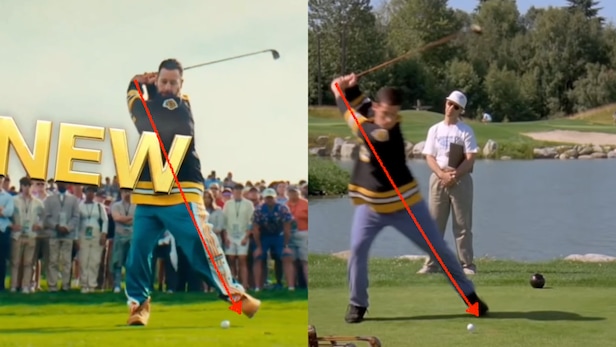U.S. Open 2024: The strangely fascinating history of Putter Boy, Pinehurst’s famous statue – Australian Golf Digest

- by Admin
- June 12, 2024

PINEHURST, N.C. — If you ever catch yourself enthralled with the statue known as Putter Boy, which stands outside the clubhouse at Pinehurst Resort, and whose image bedecks the marketing material for this week’s U.S. Open, you can thank Frank Presbrey. James Walker Tufts may have bought up the “ravaged timberland” that became the resort in 1895, and Dornoch, Scotland native Donald Ross may have designed the courses that made it famous, but in the early 1900s, somebody had to actually get people to come. That job fell to Presbrey, something of an advertising legend of the early 20th century. He became the resort’s first advertising agent, and it was from his mind that the so-called “golfer lad” was born. Like the Putter Boy who would come later, the Golf Lad wore a floppy hat, baggy pants, and boots, but he looked a little older, and two unhooked suspenders flapped at his waist. As you see from the copy below, he appeared in posters and calendars promoting the new resort, alongside such come-ons as “the only village in the south from which consumptives are excluded!”
From 1905-1914, the Golf Lad appeared annually in literature sent out across the country, and continued to appear until 1923, at which point advertisers decided that images of Donald Ross playing the various courses made for better promotional material. But before he vanished from history, at least temporarily, a crucial development happened on the resort itself. Leonard Tufts, son of James Walker Tufts, hired a Boston sculptor named Lucy Richards to make a bronze statue for the area between the two putting greens. She knew very little about golf, but she was taken by the Golf Lad and with the help of Donald Ross, who demonstrated the proper way to grip a golf club, she created the statuette that still graces the grounds today—a boy with a floppy hat, face inscrutable, lining up to hit a ball.
If you notice the actual composition of Putter Boy, though, you’ll notice that the shaft of the club appears unusually long. That’s because Richards’ intent was to make the statue a sundial, and to make it accurately tell time, the angle of the club had to be longer than would appear normal. This is also why the statue was called Sundial Boy.
At this point, historical references to Sundial Boy dry up, and Pinehurst refers to the five-decade era of silence as “The Gap.” We know that Sundial Boy continued to hold its place of prominence in the middle of the putting green, but for a time it just existed, while the Golf Lad fell out of favor in advertising.
When the ownership of the Tufts family came to an end, they sold the resort to the Diamondhead Corporation, which kicked off a decade of questionable management that ended with a $70 million debt and a forced sale back to the banks. In the midst of their 1970s run, though, Diamondhead had a few marketing successes, and Sundial Boy was one of them. For starters, they changed the name to Putter Boy, and began incorporating it into advertising literature.
David Cannon
But here’s the most shocking part of Putter Boy’s entire history: he’s only called “Putter” Boy because he was near the putting green. In fact, there is no ironclad indication that he’s holding a putter at all, and many believe that Richards’ statue depicts him holding a driver. That’s right: everything you think you know about Putter Boy is a lie.
OK, that might be overstating it a bit. But the main fact about putter boy, which is that he’s a boy who is putting, might only be 50% true.
In any case, Diamondhead’s rebranding meant a career renaissance for Putter Boy. And yet, in the midst of all this, he was essentially retired, moved from the putting green to the reliquary setting of the World Golf Hall of Fame. There he remained until 1990, when some mysterious benefactor whose name or whim is not known had it moved back outside, to where it now sits outside the clubhouse by the practice putting green.
In the meantime, Diamondhead’s rocky stewardship had given way to ClubCorb, and its founder Robert H. Dedman, who ran the ship until his death in 2002, at which point his son Robert Dedman Jr. took over. Even when the Dedmans sold ClubCorp in 2006, they held onto Pinehurst under the name…wait for it…Putter Boy Ltd. (Along with “Putter Boy,” one of the other four statues at Pinehurst belongs to Dedman; Donald Ross and Richard Tufts stand beside each other in a third, and the fourth, moved to the spectator entrance this week, belongs to Payne Stewart.)
The Dedman era has been a boon for Pinehurst in almost every way, and three years before the elder Dedman’s passing, they landed their first U.S. Open. That was the ’99 installment, when Payne Stewart hit his legendary putt, and when it came time to unveil a logo for that event, the Putter Boy (and/or the Golf Lad) made his glorious return from the shadows in graphic form, thanks to Stephen Cryan, then the director of retail operations at Pinehurst. He was back again in 2005, 2014, and this year in 2024. Check out the video below to see the evolution of the Putter Boy in U.S. Open logos, and pay special attention to the 2014 version, when Putter Boy is holding the U.S. Open in the same pose as Payne Stewart, the ’99 winner:
“The Lad is the father, in effect, to the Putter Boy,” Cryan said in ’99. “The Lad truly represents what Pinehurst is all about—youthful enthusiasm and walking No. 2. He’s been a part of our history since the early 1900s. To have him represent the U.S. Open, clearly the biggest event to ever come to Pinehurst, is a perfect match.”
The artist Eric Johnson was also commissioned to create Golf Lad posters around the time of the second U.S. Open at the resort, with the tagline “Back to Pinehurst.”
As for the nebulous difference between the Golf Lad and Putter Boy, we’ll let have Pinehurst have the last word:
“The difference is simple. Golf Lad is a character and has a personality witnessed through his various poses and moments. He moves. He is active. He is able to participate in and around the U.S. Open. Putter Boy is a statue and is always in the same pose. And we love both.”
MORE GOLF DIGEST U.S. OPEN COVERAGE U.S. Open 101: Answering all your frequently asked questions How to watch the 2024 U.S. Open Power Rankings: Every player in the U.S. Open field, ranked The 13 best bets to win at Pinehurst Tee times for Rounds 1 and 2 ‘A New Day’: USGA president Fred Perpall brings dynamic personality and drive to golf Video: Every hole at Pinehurst No. 2 Is the USGA going to set up Pinehurst extra hard because of recent low scores in majors? Tiger is playing Pinehurst on a special exemption. Here’s what it is and why he got it What would you shoot at the U.S. Open? Our new tool will tell you U.S. Open anchor sites are about far more than golf The U.S. Open champion who died in a jail cell The USGA is about to play its 1,000th championship. The best 9 stats from the first 999
This article was originally published on golfdigest.com
The Latest News
-
December 27, 2024‘The champ’s back’: Seven-year first sees Smith join legends amid Nadal comparison
-
December 27, 2024Australian Flying Foxes And Lorikeets Mysteriously ‘Fall From The Sky’: Here’s Why
-
December 27, 2024‘Extremely lucky’: Waugh takes aim over Kohli sanction
-
December 27, 2024Moore Park advocates say consultancy fee nearing $1 million is a double-bogey – Australian Golf Digest
-
December 26, 2024Live: Smith century leads Australia to 474 as fast bowlers eye Indian top order





